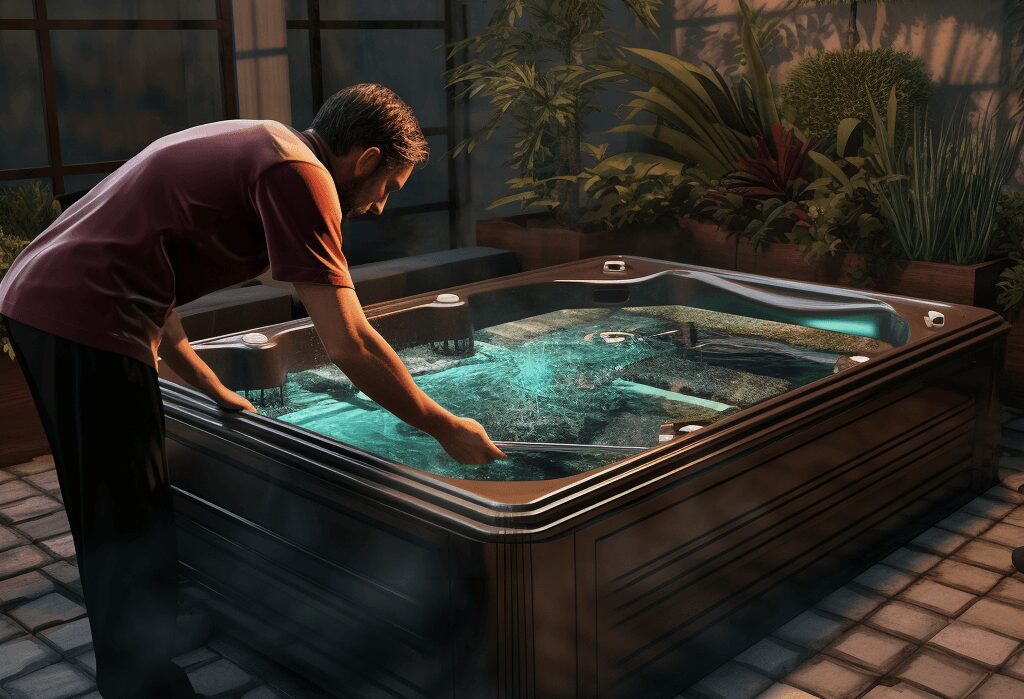Maintaining the right alkalinity levels in your hot tub is not just a matter of water chemistry; it’s a crucial aspect of ensuring a safe and enjoyable soaking experience. Alkalinity serves as a buffer to stabilize the pH levels in the water, making it less susceptible to fluctuations that can be harmful to both the hot tub equipment and its users. High alkalinity levels can lead to many problems, including cloudy water, scaling on the hot tub surfaces, and even skin irritation.
In this comprehensive guide, we will delve into the methods to effectively lower the alkalinity in your hot tub. From chemical solutions like muriatic acid to natural methods like aeration, we’ll cover all the bases to provide a reliable roadmap for managing your hot tub’s alkalinity.
What is Alkalinity and Why is it Important?
In hot tub water, alkalinity refers to the water’s ability to neutralize acids, effectively acting as a buffer that prevents sudden changes in pH levels. It is measured in parts per million (ppm) and is an essential factor in maintaining the overall water quality in your hot tub. When alkalinity is within the ideal range, it helps stabilize pH levels, ensuring that sanitizers work effectively and that the water remains clear and free from harmful microorganisms.
The ideal alkalinity levels can vary depending on the type of sanitizer you are using. For chlorine-based sanitizers, the recommended alkalinity level is between 80-120 ppm. If you’re using bromine, the ideal range is slightly higher, between 100-120 ppm. Maintaining these levels is crucial for the sanitizer to effectively kill bacteria and other pathogens.
Understanding and managing alkalinity is not just about keeping the water clear; it’s about creating a safe and comfortable environment in your hot tub. When alkalinity is too high, it can reduce the effectiveness of your sanitizers, leading to unsanitary water conditions. Therefore, knowing how to lower alkalinity when needed is an essential skill for any hot tub owner.
Methods to Lower Alkalinity
Managing the alkalinity of your spa is crucial for both the longevity of your equipment and the health of the users. Various methods exist to lower high alkalinity levels, ranging from chemical solutions to more natural approaches. Let’s explore these methods in detail.
Chemical Methods
- Muriatic Acid: One of the most effective chemicals for lowering alkalinity. It’s a strong acid and should be handled with care. Always wear gloves and eye protection when using muriatic acid. Dilute the acid in a bucket of water before slowly adding it to the hot tub, distributing it evenly. It’s advisable to start with a small amount, mix it well, and then retest the water after a few hours to see if further adjustments are needed.
- Dry Acid (Sodium Bisulfate): This is a granular form of acid and is often marketed as “pH Down” or “pH Minus.” It’s easier to handle than muriatic acid but works similarly to lower alkalinity. The amount needed will depend on the volume of your hot tub and the current alkalinity levels. Always follow the manufacturer’s instructions for dosage and application.
- pH Minus: This is another chemical option that can lower both pH and alkalinity. It’s less potent than muriatic or dry acid but can be adequate for minor adjustments. Make sure to read the label for proper dosing instructions.
Natural Methods
- Vinegar: White vinegar is a milder acid that can lower alkalinity. While it’s not as effective as chemical methods, it’s a good option for those who prefer a more natural approach. To use vinegar, add it directly to the hot tub while the jets are on to ensure thorough mixing. You’ll need to use more vinegar than you would with more potent acids, and it may take longer to see results.
- Aeration: This is a natural method that involves turning on all the jets and air features in your hot tub to introduce as much air into the water as possible. Aeration can help to raise the pH level while leaving the alkalinity relatively unchanged, making it easier to lower the alkalinity by adding a smaller amount of acid.
Each method has pros and cons, and the best approach will depend on your specific needs and preferences. Always remember to retest your water after making any adjustments to ensure that you’ve achieved the desired alkalinity level.
Dosage and Precautions
Calculating the correct acid dosage is crucial for effectively lowering alkalinity without causing harm to your hot tub or its users. The amount of acid needed will depend on the volume of your hot tub and the current alkalinity levels. Most chemical products come with a dosage chart or calculator to guide you. Generally, start with a smaller amount than recommended, as you can always add more later.
Safety should be your top priority when handling acids. Always wear protective gloves and eye gear. Make sure to dilute the acid in a bucket of water before adding it to the hot tub, and never add water to the acid, as this can cause a dangerous reaction.
Step-by-Step Guide to Lowering Alkalinity in Your Hot Tub
Lowering the alkalinity in your hot tub is a process that requires careful planning and execution. Here’s a detailed, step-by-step guide to help you through it:
- Initial Testing: The first step is to test the current alkalinity levels using a reliable water testing kit or test strips. This will give you a baseline to work from.
- Calculating the Amount of Acid Needed: Based on your initial testing, consult the dosage chart or calculator with your chosen acid product to determine the amount needed to lower the alkalinity to the desired level.
- Safety Precautions: Before handling any acids, wear your gloves and eye protection. Prepare a bucket of water for diluting the acid.
- Adding the Acid: Dilute the calculated amount of acid in the bucket of water. Turn on the hot tub jets to ensure thorough mixing, and slowly add the diluted acid to the hot tub. Distribute it evenly across the water surface to avoid concentrated areas.
- Aeration: Turn on all the jets and air features in your hot tub. This will help to raise the pH level while keeping the alkalinity relatively stable, making it easier to achieve your target alkalinity level.
- Re-testing and Adjustments: Wait a few hours for the chemicals to circulate and then retest the water. If the alkalinity is still higher than desired, you may need to repeat the process. If it’s too low, add a pH increaser to bring it back up.
- Final Testing: Once you’ve reached your target alkalinity level, perform one final test to confirm. Make any minor adjustments if necessary.
The Relationship Between pH and Alkalinity
Alkalinity and pH are closely related but distinct aspects of water chemistry in a hot tub. While pH measures the acidity or basicity of the water, alkalinity acts as a buffer that helps stabilize these pH levels. In simple terms, a proper alkalinity level makes it easier to maintain a stable pH, which is crucial for the effectiveness of sanitizers and overall water quality. A common misconception is that focusing solely on adjusting pH levels will solve water quality issues. However, without first addressing alkalinity, you may be in a never-ending battle with fluctuating pH levels, leading to ineffective sanitization and potential damage to your hot tub components.
Signs of High Alkalinity
Recognizing the signs of high alkalinity is the first step in addressing the issue effectively. Here are some indicators to watch out for:
- Cloudy Water: One of the most noticeable signs is the cloudy or murky appearance of the water.
- Scaling: High alkalinity can lead to calcium deposits, or scaling, on the hot tub surfaces and even within the plumbing, which can cause long-term damage.
- Skin and Eye Irritation: Overly alkaline water can be harsh on the skin and eyes, irritating prolonged exposure.
- Ineffective Sanitizers: You may notice that sanitizers like chlorine or bromine are not as effective, leading to unsanitary water conditions.
- Water Testing: The most accurate way to determine high alkalinity is through water testing kits or strips that measure alkalinity levels in ppm. Levels above the ideal range for your specific sanitizer indicate high alkalinity.
Troubleshooting and FAQs
Even with the best of intentions, you may encounter some challenges when trying to lower the alkalinity in your hot tub. Here are some common questions and troubleshooting tips:
- What to do if alkalinity doesn’t lower?: If you find that the alkalinity levels are not dropping as expected, double-check your calculations and the expiration date of your chemicals. Old or expired chemicals may not be effective. You may also need to consider using a stronger acid.
- How often should you test?: Regular testing is crucial for maintaining optimal water quality. Test your water at least once a week under normal conditions and more frequently if you adjust the alkalinity or pH levels.
- Is it safe to use the hot tub while adjusting alkalinity?: It’s generally not recommended to use the hot tub while you’re in the process of changing its alkalinity levels. Chemicals need time to circulate and stabilize, and using the hot tub during this period could expose you to imbalanced water conditions.
Final Thoughts
Managing the alkalinity in your hot tub is an essential aspect of overall maintenance. Proper alkalinity levels not only ensure a stable pH but also maximize the effectiveness of your sanitizers, leading to a safer and more enjoyable hot tub experience. Regular testing and timely adjustments are key to maintaining these levels. So, make alkalinity management a regular part of your hot tub care routine for a consistently delightful soaking experience.







